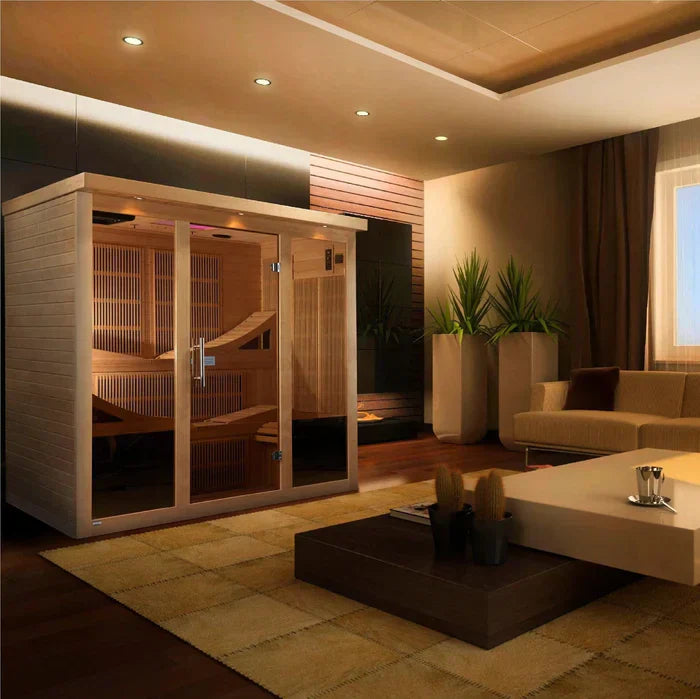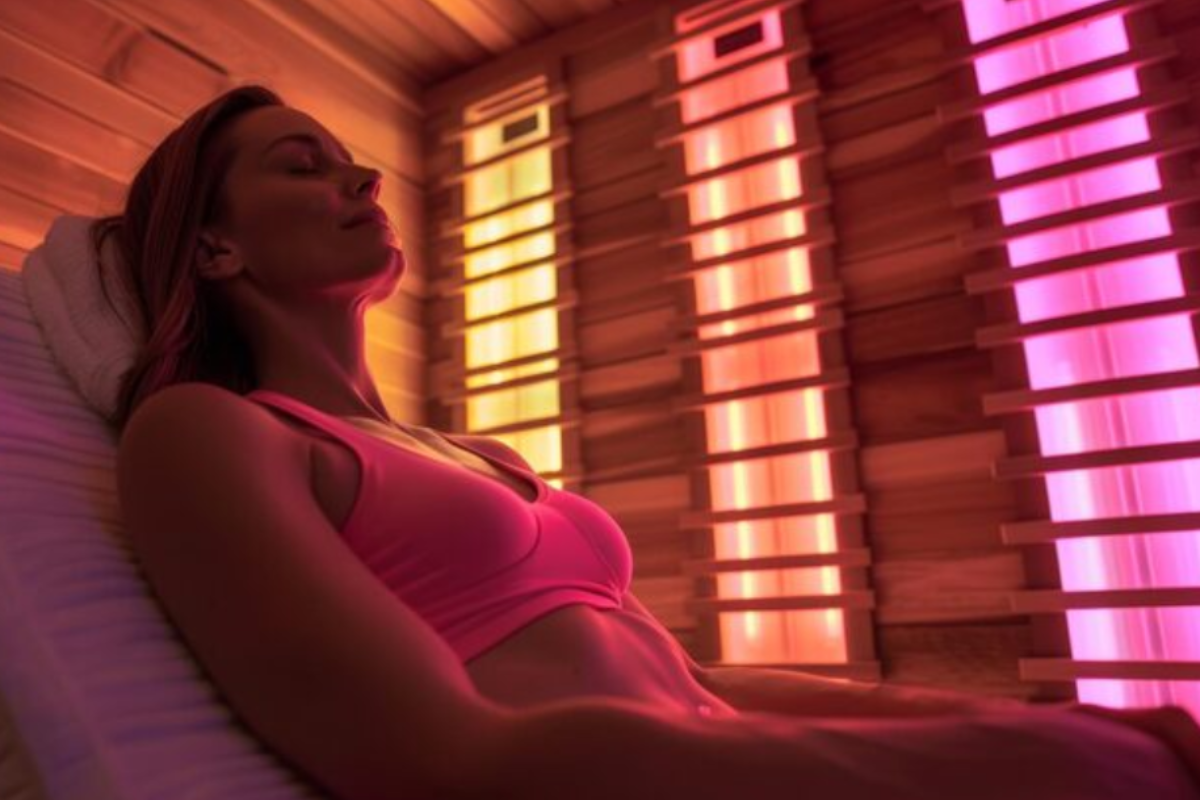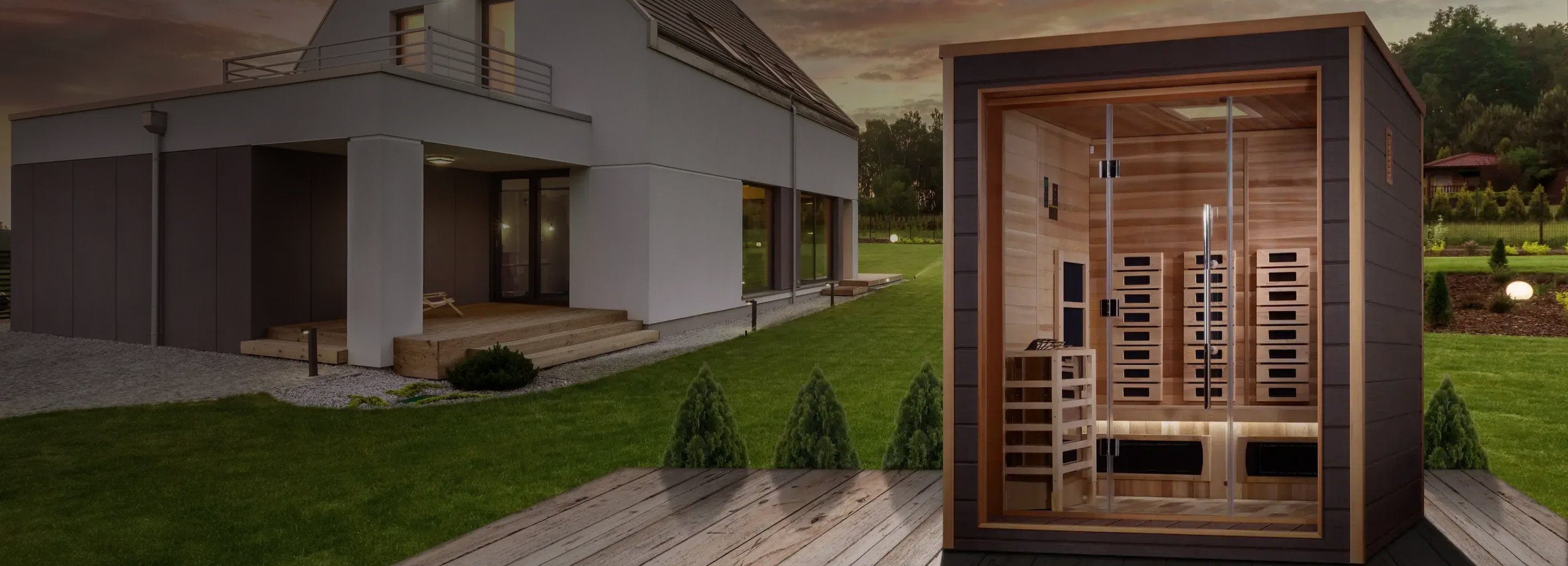Low EMF infrared saunas use shielding technology and design modifications that reduce field exposure to 1-3 mG. This is achieved through the use of grounded metal shielding around wiring, strategic heater positioning away from high-contact areas (such as where your back rests), and the use of carbon fiber heating elements that naturally produce lower fields than older ceramic rod heaters.
Ultra-low EMF saunas maintain readings below 0.5 mG throughout the cabin. These units often cost 30-50% more than standard low EMF models. But for people who are electromagnetically sensitive or who plan to use their sauna daily, that premium can be worth every penny.
If you're using your sauna four times per week for 30 minutes per session, you're logging about 100 hours annually inside that electromagnetic environment. Multiply that by years of ownership, and the distinction between 80 mG and 2 mG becomes far more significant than it might initially appear.
How Does Low EMF Infrared Saunas Work?
Let me break this down in practical terms. EMF (electromagnetic fields) are invisible areas of energy produced by electrical devices. Every electronic product in your home generates some level of EMF, including your refrigerator and laptop. The concern with infrared saunas, specifically, is that you're sitting inside an enclosed space surrounded by electrical heating elements for 20 to 45 minutes at a time, often multiple times a week.
Standard infrared saunas use basic carbon or ceramic heating panels without advanced shielding. These can produce EMF readings of 50-100+ mG at body level, which is higher than the 2.5 mG threshold that some European countries use as a precautionary guideline for continuous exposure.
Low EMF infrared saunas, on the other hand, are specifically engineered to minimize your exposure to electromagnetic fields while still delivering the same therapeutic heat benefits.
The heating elements and electrical components are arranged and insulated in a way that redirects or cancels out most of the electromagnetic output before it reaches the user.
Here are the features in detail:
Low EMF Technology and Design Features
Let me walk you through the specific technologies that separate low-EMF units from standard models.
1. Shielded wiring and positioned heating panels
Shielded wiring and positioned heating panels are the foundation of low EMF design. Premium manufacturers route all electrical wiring through grounded metal conduit, creating a Faraday cage effect that contains electromagnetic fields before they can radiate into the cabin.
The heating panels are positioned in the walls and floor, rather than directly behind seating areas, to maximize infrared coverage while minimizing EMF exposure at the body level.
2. Carbon fiber heaters
The Carbon fiber heater is the preferred technology in low EMF saunas for good reason. Unlike older ceramic rod heaters that concentrate heat in small, high-intensity points (creating stronger electromagnetic fields in the process), carbon fiber panels distribute heat evenly across large surface areas.

Maxxus 1-person S-Line low EMF Far infrared sauna with carbon tech heating panels.
This allows them to operate at lower power densities while still delivering therapeutic infrared wavelengths. The result? Effective heat therapy with EMF readings that often measure 70-80% lower than ceramic alternatives.
3. Canadian hemlock wood
The choice of Canadian hemlock wood in premium, low EMF saunas isn't just about aesthetics or durability, although both are important. Hemlock is a non-resinous wood that doesn't require chemical treatments to prevent warping in high-heat environments. This means you're not introducing additional off-gassing concerns into a space designed for detoxification.
For instance, the Maxxus 1-person S-Line low EMF Far infrared sauna is made from Canadian Hemlock wood:

The wood also provides natural insulation that allows heaters to operate more efficiently at lower power settings, which further reduces electromagnetic field generation.
4. EMF readings and testing standards
Reputable manufacturers provide third-party EMF testing reports with their saunas, showing measurements taken at multiple points inside the cabin at sitting height. Look for documentation that specifies testing methodology. Was it measured with the door open or closed? At what distance from the heaters? With one person or two inside?
According to standards set by the Building Biology Institute, ideal EMF exposure during sleep or extended rest should be below 1 mG. While sauna use isn't sleep, it is a time when your body is in a deeply relaxed, detoxifying state, and the time when you want minimal electromagnetic interference. Quality low EMF saunas should meet or exceed this standard throughout the entire cabin, not just in select "sweet spots" away from the heaters.
Benefits of Low EMF Infrared Saunas
Let me explain why the "low EMF" specification transforms infrared therapy from potentially problematic to genuinely therapeutic.
1. It detoxifies and relaxes the body
A study published in the Journal of Environmental and Public Health found that exposure to EMFs can increase free radical production and reduce the body's antioxidant capacity. That's the exact opposite of what you're trying to achieve during sauna detox sessions.
With a low EMF unit, you’ll experience increased circulation, activated sweat glands, and mobilized toxins, all without the electromagnetic interference that could compromise these processes.
2. It reduces body fatigue
Reduced sleep disturbances and fatigue associated with high EMF exposure are among the most commonly reported benefits among individuals who switch from standard to low EMF saunas.
Research published by the National Health Institute documented the relationship between EMF exposure and disrupted melatonin production, the hormone that regulates sleep-wake cycles. While a 30-minute sauna session might not seem like a significant exposure, if you're doing this several times per week in a high-EMF environment, those effects accumulate.
Low EMF saunas remove this variable, and allow the natural relaxation response triggered by heat therapy to translate into better sleep quality rather than being undermined by electromagnetic stress.
3. Eliminates toxins at the cell level
Your mitochondria, the powerhouses of your cells, are sensitive to electromagnetic fields. Studies have shown that EMF exposure can impair mitochondrial function, reduce ATP (cellular energy) production, and increase the production of reactive oxygen species (free radicals).
During sauna therapy, when your cells are actively working to mobilize and eliminate toxins, you want your mitochondria to operate at peak efficiency, not struggle against electromagnetic interference.
4. It reduces inflammation and body pain
Infrared heat therapy has anti-inflammatory effects. A study published in Clinical Rheumatology found that the use of infrared saunas reduced pain and stiffness in patients with rheumatoid arthritis and ankylosing spondylitis. However, inflammation is also influenced by electromagnetic stress; research indicates that EMF exposure can trigger inflammatory responses in individuals who are sensitive to it.
By using a low EMF sauna, you can address inflammation through heat therapy without triggering it through electromagnetic exposure. This is a cleaner, more consistent therapeutic approach.
Types of Low EMF Infrared Saunas
Not all low EMF saunas deliver the same wavelengths of infrared light, and understanding these differences helps you match the right type to your specific wellness goals. Let me break down the main categories and what makes each one valuable.
1. Full-Spectrum Infrared Saunas
Full-spectrum sauna models emit all three infrared wavelengths (near, mid, and far) with each penetrating to different tissue depths and offering distinct therapeutic benefits:
- Near-infrared (NIR) light reaches approximately 1-2mm into the skin and is effective for surface-level healing, skin rejuvenation, and wound repair.
- Mid infrared (MIR) penetrates deeper, supporting circulation and pain relief.
- Far infrared (FIR) penetrates the deepest, reaching up to 1.5 inches. This makes it ideal for detoxification, muscle recovery, and core body temperature elevation.
I've found that full-spectrum saunas appeal most to buyers who want versatility and flexibility. You're getting three therapy modalities in one unit, and many modern full-spectrum models allow you to adjust the wavelength mix based on your goals for each session. Targeting muscle soreness after a workout? Go for far infrared. Working on skin health? Dial up the near infrared component.

Finnmark FD-2 Full Spectrum 2-Person Infrared Sauna
The challenge with full-spectrum saunas from an EMF perspective is complexity. It comes with various heater types and control systems, which means more potential sources of electromagnetic fields. This is why it's absolutely critical to verify EMF testing data for full-spectrum models, not just far infrared ratings from the same manufacturer.
Premium full-spectrum low EMF saunas will show readings under 3 mG even with all wavelength emitters operating simultaneously, but budget versions may spike significantly higher when full-spectrum mode is engaged.
Understanding the distinct therapeutic applications of each infrared wavelength helps you make a more informed decision about which sauna type aligns with your wellness goals. Our comprehensive comparison of near vs far infrared saunas breaks down the penetration depths, optimal use cases, and research-backed benefits of each wavelength, making it easier to determine whether full-spectrum versatility or far infrared focus better serves your needs.
2. Far Infrared Saunas
Far infrared (FIR) saunas focus on the longest infrared wavelengths, which penetrate deepest into tissue and are primarily responsible for the core body heating and heavy sweating associated with detoxification protocols. If your main goal is to eliminate heavy metals, BPA, and other stored toxins, FIR saunas are the proven, research-backed choice.
From an EMF perspective, FIR-only saunas use simpler heating systems, which mean fewer electromagnetic field sources to shield. A well-designed carbon fiber FIR sauna can achieve ultra-low EMF ratings (under 1 mG) more easily than full-spectrum models because there's simply less electrical complexity involved.
I recommend FIR saunas to buyers primarily focused on detoxification, chronic pain management, or cardiovascular benefits. According to this research from the National Library of Medicine, far-infrared saunas might be of help to people who have cardiovascular or respiratory problems.
For a comprehensive understanding of how far infrared wavelengths work at the cellular level and why they're the preferred choice for detoxification protocols, explore our detailed guide on what far infrared saunas are and their therapeutic mechanisms.
3. Portable and Two-Person Low EMF Infrared Saunas
Portable infrared saunas offer the most budget-friendly and space-efficient entry into low EMF infrared therapy. I've seen these transform wellness routines for people living in apartments, travellers, or simply not ready to commit to a permanent installation.
That said, EMF performance varies in portable models. Many budget portable saunas use compact heater designs that, by necessity, operate at higher power densities in proximity to your body.
Quality portable low EMF saunas, for instance, use carbon fiber heating pads with integrated shielding that maintain readings under 3 mG. These units sacrifice the experience and capacity of full-size saunas, but for someone who wants daily infrared exposure without the footprint or investment of a cabin sauna, they're worth it.
Two-person low EMF saunas are the sweet spot for couples or small families. These units measure about 4' x 4' x 6' tall, which is enough space for two adults to sit comfortably without feeling cramped, but compact enough to fit in a master bedroom, home gym, or converted closet space.
From an engineering perspective, two-person models can actually maintain lower EMF levels more easily than single-person units because the larger cabin volume allows for better heater spacing and distribution.
Look for models with heaters positioned in the walls and floor rather than concentrated on the back wall. This creates more even infrared coverage while keeping electromagnetic fields distributed away from high-contact seating areas.
Factors to Consider Before Buying a Low EMF Infrared Sauna
I've guided hundreds of buyers through sauna purchases over the years, and the ones who end up thrilled with their investment are always the ones who asked the right questions upfront. Let me walk you through the factors that actually matter.
1. EMF Safety and Certification
This should be your non-negotiable starting point. Any manufacturer claiming ‘low EMF’ should provide third-party EMF testing reports, not just internal company measurements.
Look for documentation from testing labs that specifies measurement methodology, locations tested within the cabin, and whether testing was conducted with the sauna at operating temperature (EMF levels can change as heaters reach full power).
The reading numbers also matter. Readings under 3 mG at sitting height is the baseline for ‘low EMF’ sauna. Under 1 mG qualifies as ‘ultra-low EMF’ and is the gold standard for people who are electromagnetically sensitive or planning daily use.
Be wary of companies that only provide a single "average" reading. You want to see EMF measurements from multiple locations, especially at torso and head height, where you'll be positioned during sessions.
2. Heating System
Carbon fiber heating panels are the industry standard in quality, low EMF saunas. This is because they offer even heat distribution, rapid warm-up times, and naturally lower EMF generation compared to ceramic rod heaters.
But not all carbon fiber systems are equal. Look for panels that cover a significant wall surface area (ideally 360-degree coverage) rather than concentrated in a few small sections.
Greater surface coverage means each heater can operate at lower power density while still achieving therapeutic cabin temperatures. And lower power density directly translates to lower EMF generation.
3. Wood Quality
Wood quality and safety matter more than most buyers realize. I mentioned Canadian hemlock earlier, but other non-resinous woods, such as basswood and poplar, also work well.
The critical factors are:
- No chemical treatments (you'll be breathing deeply in this enclosed space while your pores are open)
- No off-gassing from adhesives or finishes
Pay attention to the wood thickness as well. Premium saunas use tongue-and-groove panels at least 8-10mm thick, which provides better insulation and structural integrity than the 6mm boards found in budget models. This is because better insulation means your heaters don't have to work as hard to maintain temperature, which reduces electricity costs and EMF generation during operation.
4. Extra Features for Comfort and Experience
Once you've verified EMF safety and core construction quality, comfort features become the differentiators that determine whether your sauna becomes a daily habit or an expensive storage closet.
Some features to consider are:
-
Chromotherapy
Chromotherapy (color light therapy) might sound like a gimmick, but there's actual research supporting its therapeutic benefits. Different light wavelengths influence mood, energy levels, and even pain perception. I've had clients who use red light during evening sessions to support sleep and blue light during morning sessions for energizing effects.
The therapeutic applications of light therapy extend beyond chromotherapy's mood-enhancing benefits. For readers interested in understanding how red light therapy compares to infrared heat therapy for specific health outcomes, our guide to red light vs infrared sauna benefits examines the distinct mechanisms, optimal wavelengths, and clinical research supporting each modality.
Here’s the blue light in the Finnark FD-2 full-spectrum sauna:

Here’s how the red light looks:

-
Sound systems
Sound systems and entertainment options transform the sauna experience, especially for longer sessions. Built-in Bluetooth speakers allow you to listen to meditation tracks, podcasts, or music without bringing electronics into the high-heat environment.
-
Oxygen ionization and air purification systems
Oxygen ionization and air purification systems are becoming common in higher-end models. These features minimize EMF exposure while improving air quality inside the cabin. They come in handy if you use your sauna for detoxification purposes and want to avoid rebreathing the toxins you're releasing through sweat.
5. Size and Space Requirements
Be realistic about installation space before you fall in love with a specific model. Measure twice, order once, and remember you need clearance on all sides for ventilation and maintenance access.
One-person saunas, for instance, require about 3' x 3' of floor space with 6'6" ceiling height. Two-person models need closer to 4' x 4'. Corner units can maximize space efficiency in tight areas.
Don't forget electrical requirements. Most infrared saunas operate on standard 120V household outlets, but larger models or full-spectrum units may require a 240V dedicated circuit. That means you’ll need to factor in electrician costs on top of the sauna purchase to avoid sticker shock later.
6. Warranty and Customer Support
A comprehensive warranty signals the manufacturer's confidence in their product and gives you recourse if something goes wrong.
Look for at least 5-year warranties on heaters and heating systems (these are the critical components), 3-5 years on electrical components, and lifetime warranties on structural elements, such as wood framing.
However, warranty terms only matter if the company will still be in existence to honor them. Research the manufacturer's track record. How long have they been in business? What do customer reviews say about their support responsiveness? I've seen too many buyers purchase from fly-by-night operations offering impossibly low prices, only to discover twelve months later that the company has vanished and their warranty is worthless.
You can send a message to our sauna experts for personalized recommendations.
Conclusion
Whether you choose a full-spectrum model for versatility, a far-infrared unit for focused detoxification, or a portable system for convenience, ensure you get verified low EMF performance. Request third-party testing reports. Ask specific questions about shielding technology and heater design. Don't settle for vague assurances when concrete data should be readily available.
If you're ready to explore low EMF infrared sauna options that meet the standards I've outlined in this article, browse our top low EMF saunas, each one independently tested and backed by transparent documentation.
Or schedule a consultation with one of our sauna specialists who can help you match the right model to your space, budget, and wellness goals.




